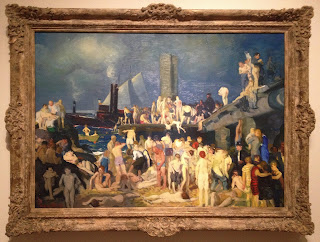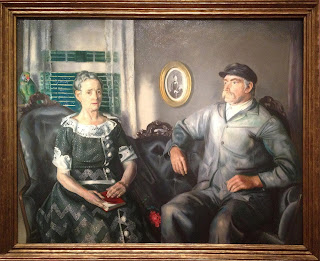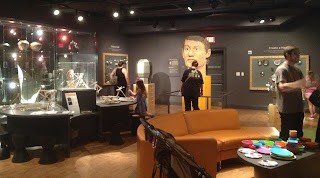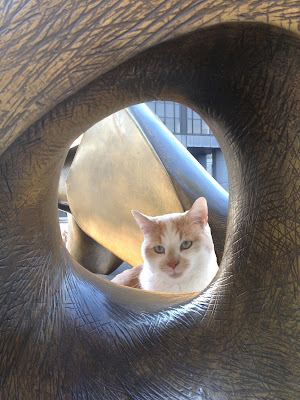A broad overview of a major Ohio artist’s paintings
and lithographs at the Columbus Museum of Art
 |
| Entrance to the Columbus Museum of Art |
George Bellows was born and raised in Columbus, though he made his name in New York after dropping out of OSU as a junior. He’s most well known for his paintings of boxers from
the first two decades of the 20th century. They’re tough, kinetic, and his use of chiaroscuro focuses the viewer. The Columbus Museum of Art is currently showing about thirty of his paintings and around the same number of lithographs through January 4th. He was prolific, producing over a thousand works, especially when recalling that his career was about twenty years because he died suddenly of a ruptured appendix.
 |
| Stag at Sharkey's by George Bellows |
 |
| Initiation in the Frat, a 1917 Lithograph |
This exhibition displays Bellows’ versatility and his place in the development of realism as an art movement and lithography becoming a medium of choice for him. He was heavily influenced by Impressionism and Post Impressionism, as were most artists of that era. His subjects, though, were local and personal including views of Columbus and the initiation (hazing) rituals of the Beta fraternity. Once he was in New York in his early twenties, his work took off as he painted immigrants, urban landscapes, portraits, and pretty much everything else.
 |
| Riverfront No.1, 1915 |
Some of his society portraits were directly related to John Singer Sargent, just as his lithographs possess the sardonic humor of Goya’s
Caprichos series of prints. The background figures look like caricaturized demons. By the way, and I don’t know why I didn’t review it, but I saw the
Caprichos last summer in a beautifully lit exhibit at the University of Wyoming Art Museum. He also shared Goya’s outrage at the hypocrisy of the ruling class. Unfortunately, he didn’t live to see the Depression or World War II or the Holocaust and I can only imagine how he would have viewed those historical ruptures. He cited Matisse and the Fauvists as the influence for his palette, but I think he lit boxers like Degas did with ballet dancers.
 |
| Mr. and Mrs. Phillip Wase, 1924 |
Bellows’ influence in Modern American art is readily apparent in the blowsy 1930s New York images that Reginald Marsh presented and that were critiqued as ‘realistic.’ One of his later portraits of a couple in Woodstock had the severe, mythic feel of a Grant Wood subject with the romantic draftsmanship of Thomas Hart Benton. Both of those younger artists must have seen it.
 |
| The New Addition |
A couple of caveats about the Columbus Museum of Art are that it’s small (smaller maybe than our own Taft), but they’re about to start a construction project to more than double it in size by 2015, and there are some terrific areas for families to interact with and create some art. It's certainly something to consider on a Sunday, when it’s free.
 |
| The Wonder Room for All Ages |
The exhibit continues through January 4, 2014.
 |
Dexter with Three Piece Reclining Figure: Draped
by Henry Moore |



No comments:
Post a Comment